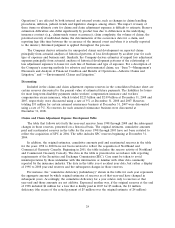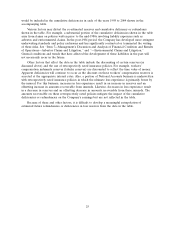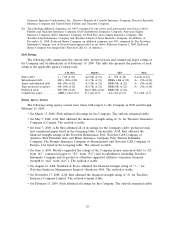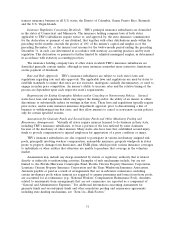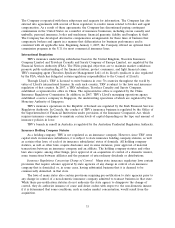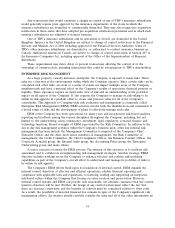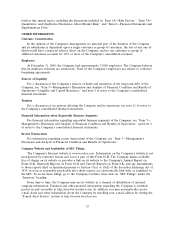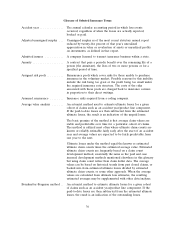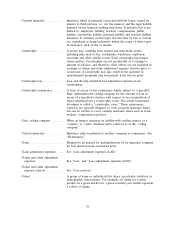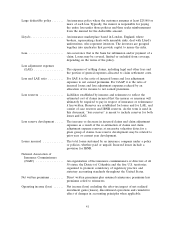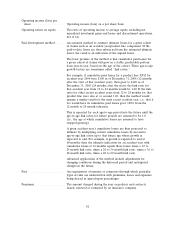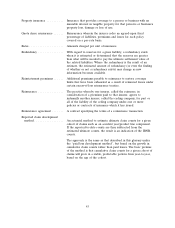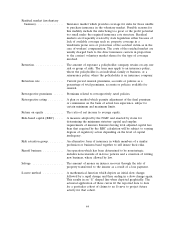Travelers 2008 Annual Report Download - page 46
Download and view the complete annual report
Please find page 46 of the 2008 Travelers annual report below. You can navigate through the pages in the report by either clicking on the pages listed below, or by using the keyword search tool below to find specific information within the annual report.Any transactions that would constitute a change in control of any of TRV’s insurance subsidiaries
would generally require prior approval by the insurance departments of the states in which the
insurance subsidiaries are domiciled or commercially domiciled. They may also require pre-acquisition
notification in those states that have adopted pre-acquisition notification provisions and in which such
insurance subsidiaries are admitted to transact business.
One of TRV’s insurance subsidiaries and its operations at Lloyd’s are domiciled in the United
Kingdom. Insurers in the United Kingdom are subject to change of control restrictions in the Financial
Services and Markets Act of 2000 including approval of the Financial Services Authority. Some of
TRV’s other insurance subsidiaries are domiciled in, or authorized to conduct insurance business in,
Canada. Authorized insurers in Canada are subject to change of control restrictions in Section 407 of
the Insurance Companies Act, including approval of the Office of the Superintendent of Financial
Institutions.
These requirements may deter, delay or prevent transactions affecting the control of or the
ownership of common stock, including transactions that could be advantageous to TRV’s shareholders.
ENTERPRISE RISK MANAGEMENT
As a large property casualty insurance enterprise, the Company is exposed to many risks. These
risks are a function of the environments within which the Company operates. Since certain risks can be
correlated with other risks, an event or a series of events can impact multiple areas of the Company
simultaneously and have a material effect on the Company’s results of operations, financial position or
liquidity. These exposures require an entity-wide view of risk and an understanding of the potential
impact on all aspects of the Company. It also requires the Company to manage its risk-taking to be
within its risk appetite in a prudent effort to create and preserve value for all of the Company’s
constituents. This approach to Company-wide risk evaluation and management is commonly called
Enterprise Risk Management (ERM). ERM activities involve both the identification and assessment of
a broad range of risks and the development of plans to effectively manage such risks.
ERM at the Company has been operational for many years and incorporates risk-based analytics,
reporting and feedback among the various disciplines throughout the Company, including, but not
limited to, the underwriting, claim, reinsurance, investment, legal, regulatory, actuarial, finance and
technology functions. Board oversight of ERM is provided by the Risk Committee. In addition to the
day-to-day risk management activities within the Company’s business units, other key internal risk
management functions include the Management Committee (comprised of the Company’s Chief
Executive Officer and the other most senior members of management), the Risk Committee of
management, the Credit Committee, the Chief Compliance Officer, the Business Conduct Officer, the
Corporate Actuarial group, the Internal Audit group, the Accounting Policy group, the Enterprise
Underwriting group and many others.
A senior executive oversees the ERM process. The mission of this executive is to facilitate risk
assessment and to collaborate in implementing risk management strategies. Another strategic ERM
objective includes working across the Company to enhance effective and realistic risk modeling
capabilities as part of the Company’s overall effort to understand and manage its portfolio of risks to
be within its risk appetite.
The Company’s ERM efforts build upon its foundation of internal control. ERM expands the
internal control objectives of effective and efficient operations, reliable financial reporting and
compliance with applicable laws and regulations, to fostering, leading and supporting an integrated,
risk-based culture within the Company that focuses on value creation and preservation. However,
internal control systems and ERM can provide only reasonable, not absolute, assurance that the control
system’s objectives will be met. Further, the design of any control system must reflect the fact that
there are resource constraints, and the benefits of controls must be considered relative to their costs.
As a result, the possibility of material financial loss remains in spite of the Company’s significant risk
management efforts. An investor should carefully consider the risks and all of the other information set
34


